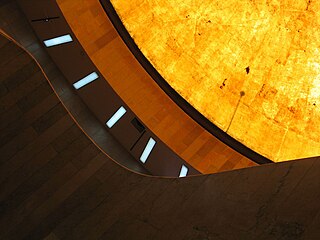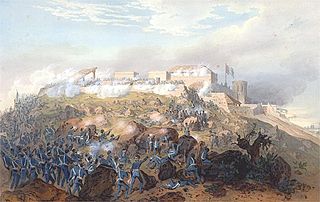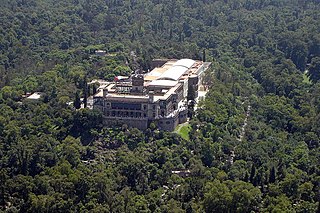 W
WChapultepec, more commonly called the "Bosque de Chapultepec" in Mexico City, is one of the largest city parks in the Western Hemisphere, measuring in total just over 686 hectares. Centered on a rock formation called Chapultepec Hill, one of the park's main functions is an ecological space in Greater Mexico City. It is considered the first and most important of Mexico City's "lungs", with trees that replenish oxygen to the Valley of Mexico. The park area has been inhabited and considered a landmark since the Pre-Columbian era, when it became a retreat for Aztec rulers. In the colonial period, Chapultepec Castle was built here, eventually becoming the official residence of Mexican heads of state. It would remain so until 1940, when it was moved to another part of the park called Los Pinos.
 W
WThe Museo de Arte Moderno is located in Chapultepec park, Mexico City, Mexico.
 W
WMetro Auditorio is a Mexico City Metro station located on line 7. It is one of the main metro gateways to the chic and business-related neighbourhood, Polanco. The entrances to the station are on Paseo de la Reforma, one of the main thoroughfares in Mexico City.
 W
WNational Auditorium is an entertainment center at Paseo de la Reforma #50, Chapultepec in Mexico City.
 W
WThe Baths of Chapultepec as a series of deposits used from the pre-Columbian period until the beginning of the 20th century, to houses the waters of the springs of the hill of Chapultepec that served to provide drinking water to Mexico City. Among the remains of these are the so-called Baths of Moctezuma in Chapultepec which was recently remodeled, and the remains of some colonial baths in the Well 5 or Manantial Chico of Chapultepec.
 W
WThe Bridge of the Lions is a bridge along Av Juventud Heroica in Mexico City, Mexico, adjacent to Chapultepec. Completed in 1975, the bridge features four bronze sculptures of lions and is flanked by cypress gardens.
 W
WThe Cárcamo de Dolores is a hydraulic structure located on the Second Section of Chapultepec Park, in Mexico City, comprising the building designed by architect Ricardo Rivas, inside the originally underwater mural Agua, el origen de la vida of Mexican muralist Diego Rivera, the art installation Cámara Lambdoma by Ariel Guzik, and in outside, the Tlaloc Fountain, also of Rivera.
 W
WCasa del Lago was instituted in 1959 as the first off-campus Cultural Center of the National Autonomous University of Mexico. It is characterized by its extraordinary ability to promote the cultural and generational encounter between the vanguard and tradition. It was established with Juan José Arreola as its founding director and is located in the Woods of Chapultepec, a traditional Sunday walk area for the inhabitants of the capital.
 W
WChapultepec Castle is located on top of Chapultepec Hill in Mexico City's Chapultepec park. The name Chapultepec is the Nahuatl word chapoltepēc which means "at the grasshopper's hill". The castle has such unparalleled views and terraces that historian James F. Elton wrote that they can't "be surpassed in beauty in any part of the world". It is located at the entrance to Chapultepec Park at a height of 2,325 meters above sea level. The site of the hill was a sacred place for Aztecs, and the buildings atop it have served several purposes during its history, including that of Military Academy, Imperial residence, Presidential residence, observatory, and since the 1940s, the National Museum of History. Chapultepec, along with Iturbide Palace, are the only royal palaces in North America.
 W
WChapultepec Zoo is a zoo located in Chapultepec Park; it is one of four zoos near Mexico City, and the best known Mexican zoo. It was founded July 6, 1923 by Mexican biologist Alfonso Luis Herrera using donations from private citizens and governmental funds from the Ministry of Agriculture and Development, and also with funds from the Society of Biological Studies.
 W
WThe Battle of Chapultepec on 13 September 1847 was an assault by invading American forces on a small contingent of Mexican forces holding the strategically located Chapultepec Castle just outside Mexico City. The building, sitting atop a 200-ft (60-m) hill, was an important position for the defense of the city. For the campaign to take Mexico City, of which the Battle of Chapultepec is a part, General Winfield Scott's U.S. Army totaled 7,200 men. General Antonio López de Santa Anna deployed Mexican forces to several sites to defend the capital, so just 880 troops, including military cadets of the Military Academy defended the position at Chapultepec against 2,000 U.S. forces. The Mexican forces' loss opened the way to take the center of Mexico City. In Mexican history, the battle is cast as the story of the brave deaths of six cadets, the Niños Héroes, who leapt to their deaths rather than be taken captive, with one wrapping himself in the Mexican flag. The U.S. has many depictions of the battle from their point of view. Although it lasted only about 60–90 minutes, the battle has great importance in the histories of both countries.
 W
WEl Sargento is a Mexican cypress tree in Mexico City's park Chapultepec, planted by Nezahualcoyotl c. 1460. After living for approximately 500 years, the tree died in 1969, and its trunk stands today at around 50 feet tall.
 W
WThe Estela de Luz is a monument in Mexico City built in 2011 to commemorate the bicentenary of Mexico's independence from Spanish rule. Its design was the winning entry in an invited competition to seek the best combination of Mexico's past and future; the design uses quartz and electric lighting to achieve this effect. The main use of the Estela De Luz will be for cultural events.
 W
WLa Feria de Chapultepec, simply branded as La Feria, was an amusement park in Mexico City, Mexico. Located in the middle of Chapultepec Park near the Constituyentes Metro station, it opened in 1964 as Juegos Mecánicos de Chapultepec and was originally operated by the Mexican government. In 1992 Grupo CIE bought it and changed the name to La Feria Chapultepec Mágico. In 2015, it was bought by Ventura Entertainment and renamed to its last name.
 W
WQuimera ("Chimera") is a roller coaster that operated at La Feria Chapultepec Mágico in Mexico City, Mexico.
 W
WThe Monumento a los Niños Héroes, officially Altar a la Patria, is a monument commemorating the Niños Héroes, installed in Chapultepec, Mexico City, Mexico.
 W
WThe Museo del Caracol is a Mexican history museum, at the bottom of the access ramp to the Castillo de Chapultepec in Mexico City. The “Snail Museum” is a spiral shaped building designed by the architect Pedro Ramirez Vazquez. The director is Patricia Torres Aguilar Ugarte. It is opens from Tuesday to Thursday from 9:00 to 16:45.
 W
WThe National Museum of Anthropology is a national museum of Mexico. It is the largest and most visited museum in Mexico. Located in the area between Paseo de la Reforma and Mahatma Gandhi Street within Chapultepec Park in Mexico City, the museum contains significant archaeological and anthropological artifacts from Mexico's pre-Columbian heritage, such as the Stone of the Sun and the Aztec Xochipilli statue.
 W
WMuseo Rufino Tamayo is a public contemporary art museum located in Mexico City's Chapultepec Park, that produces contemporary art exhibitions, using its collection of modern and contemporary art, as well as artworks from the collection of its founder, the artist Rufino Tamayo.
 W
WThe Obelisco a los Niños Héroes is a monument installed in Chapultepec, Mexico City. The cenotaph was created in 1881 by architect Ramón Rodríguez Arangoity, one of the cadets captured in the Battle of Chapultepec. The marble cenotaph was a typical nineteenth-century monument. This one lists the names of the six cadets, the Niños Héroes, killed in the fierce fighting in the Mexican-American War as military cadets defended as well as the 40 who survived the attack. For his own political purposes, General Porfirio Díaz inaugurated the monument with a military and civilian audience of dignitaries. Subsequently, the obelisk became an annual site of remembrance for the Association of the Military College, a group of veterans who had been cadets. This modest-sized monument was superseded in 1952 by the massive Monumento a los Niños Héroes.
 W
WThe Panteón Civil de Dolores is the largest cemetery in Mexico and contains the "Rotonda de las Personas Ilustres". It is located on Constituyentes Avenue in the Miguel Hidalgo borough of Mexico City, between sections two and three of Chapultepec Park.
 W
WThe statue of Franklin D. Roosevelt is installed in Chapultepec, Mexico City, Mexico. The sculpture depicts him standing upright and is 3 m (9.8 ft) tall. This portrayal of Roosevelt is unusual because he suffered from paralytic illness and was unable to walk unaided after his 1920 campaign for vice president. The statue is found close to the National Museum of Anthropology. It was made by Mexican sculpturist Jorge de la Peña Beltrán.
 W
WThe statue of León Felipe is installed in Mexico City's Chapultepec park, in Mexico. The statue was created by Julián Martinez in 1973, and dedicated in 1974.
 W
WTemplanza Fountain is a fountain in Chapultepec, Mexico City, Mexico.
 W
WTribuna Monumental, or the Monumento a las Águilas Caídas, is a monument in Chapultepec, Mexico City, commemorating Mexican army officers in Squadron 201, who fought on the Pacific front during World War II.